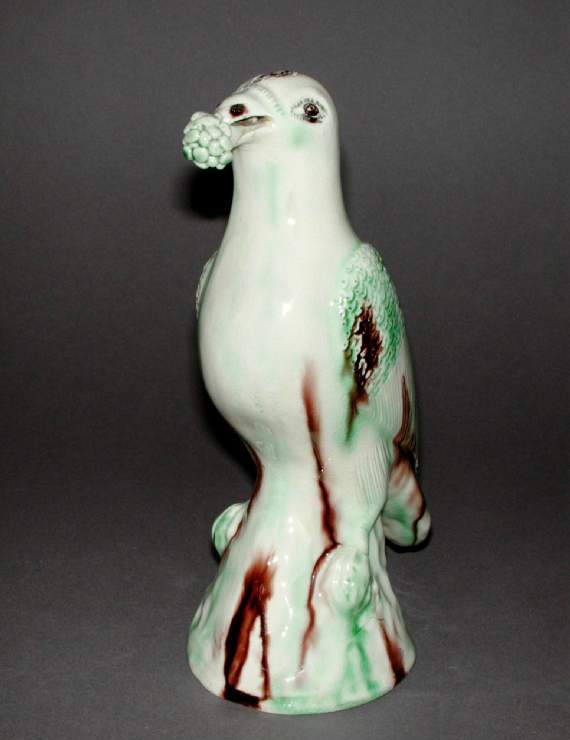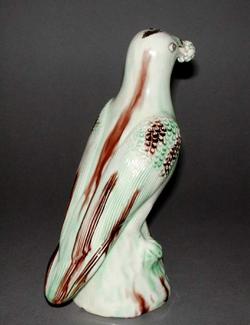Awaiting location update
Titles
Pigeon
Maker(s)
Production:
Unidentified Staffordshire factory
(Probably)
Entities
Categories
Description
Cream earthenware streaked with brown and green under lead-glaze
Cream earthenware, moulded (probably slip cast), with incised indications of feathers, streaked with manganese-brown and green oxide colours under lead-glaze. The underside is closed and has a large circular ventilation hole in the centre. The bird is standing with its feet on either side of a conical rocky mound. It faces to the front and holds a large blackberry in its beak.
Notes
History note: Mr F. L. Furphey, Oakwood, Priory Road, Sale, in a letter offered to sell the bird on 1 January 1918 for £40. It was sent on approval to Cambridge, where bought for that amount on 27 January 1918 by Dr J.W.L. Glaisher, FRS, Trinity College, Cambridge.
Legal notes
Dr J. W. L. Glaisher Bequest
Measurements and weight
Height: 22 cm
Length: 14.2 cm
Acquisition and important dates
Method of acquisition: Bequeathed
(1928-12-07)
by
Glaisher, J. W. L., Dr
Dating
18th Century, third quarter
George II or George III
Circa
1750
-
1770
Note
The popularity of bird models in pottery and porcelain from the mid 18th century was a reflection of increasing interest in the natural world and the publication of illustrated books on ornithology such as George Edward's A Natural History of Birds, published in four volumes between 1743, 1747, 1750 and 1751, which provided models for craftsmen to copy. Exotic birds could be could be studied in aviaries and menageries, such as the 2nd and 3rd Dukes of Richmond in England in Whitehall and the Duke of Montague’s at Blackheath, and talking birds, such as parrots, were popular pets for less wealthy people. Many were brought back alive or stuffed by officers and crew members of ships returning from non-European parts of the world. Modellers of ceramic figures were also influenced by imported Chinese porcelain figures of parrots and other birds. The beak of this bird seems broader than a pigeon's, and it may have been iintended to be a parrot.
Components of the work
Decoration
composed of
oxide colours
( manganese-brown and copper ?-green)
Surface
composed of
lead-glaze
Base
Depth 9.2 cm
Width 8.5 cm
Materials used in production
cream
Earthenware
Techniques used in production
Moulding
: Cream earthenware, moulded (possibly slip cast) with incised details, and applied blackberry, streaked and dabbed with manganese-brown and copper-green oxide colours under lead-glaze
Inscription or legends present
- Text: illegible
- Location: On underside
- Method of creation: Probably hand-written in ink
- Type: Label
References and bibliographic entries
Identification numbers
Accession number: C.839-1928
Primary reference Number: 76207
Old object number: 4657
Stable URI
Audit data
Created: Saturday 6 August 2011
Updated: Tuesday 30 April 2024
Last processed: Tuesday 15 July 2025
Associated departments & institutions
Owner or interested party:
The Fitzwilliam Museum
Associated department:
Applied Arts





